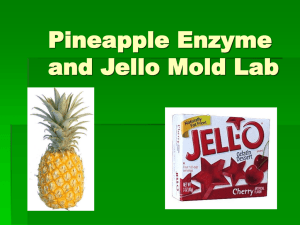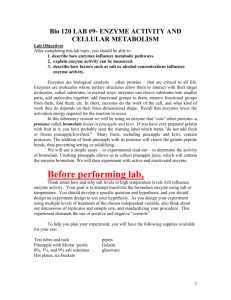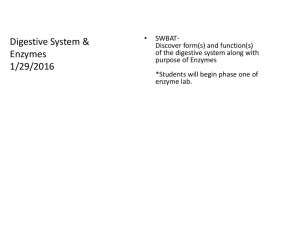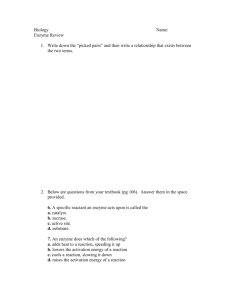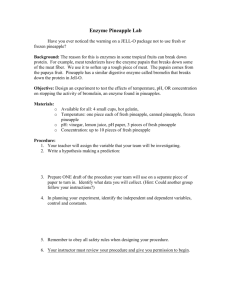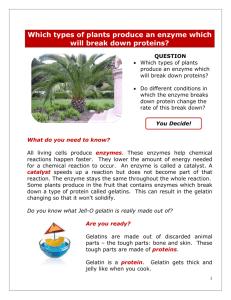Enzyme Lab 1
advertisement
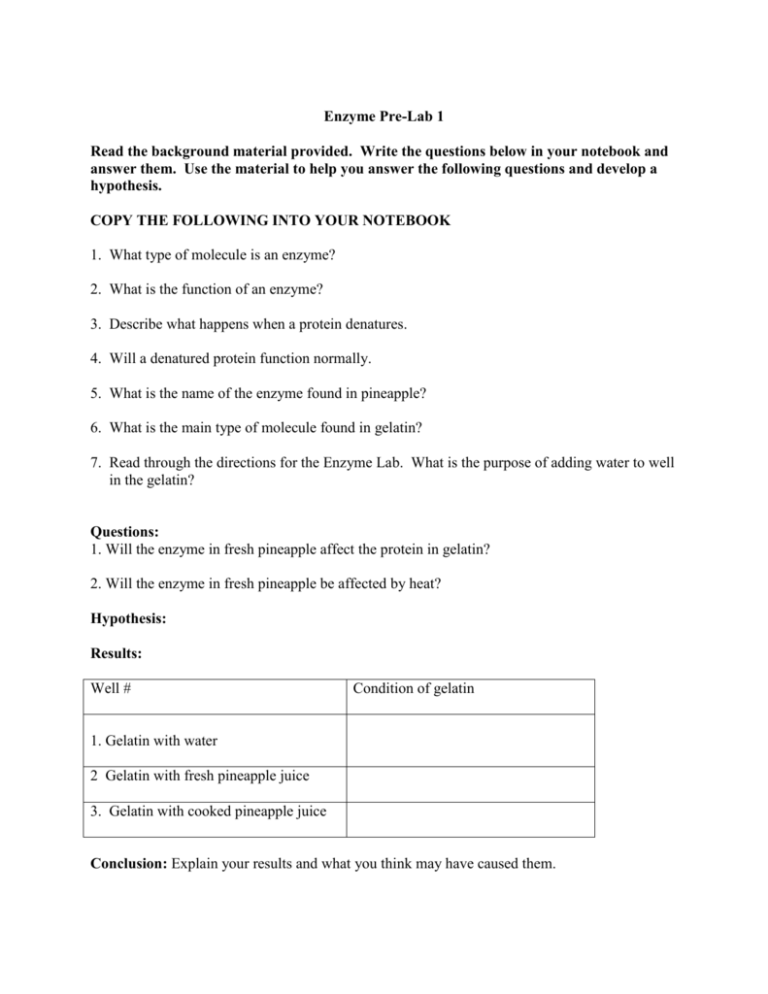
Enzyme Pre-Lab 1 Read the background material provided. Write the questions below in your notebook and answer them. Use the material to help you answer the following questions and develop a hypothesis. COPY THE FOLLOWING INTO YOUR NOTEBOOK 1. What type of molecule is an enzyme? 2. What is the function of an enzyme? 3. Describe what happens when a protein denatures. 4. Will a denatured protein function normally. 5. What is the name of the enzyme found in pineapple? 6. What is the main type of molecule found in gelatin? 7. Read through the directions for the Enzyme Lab. What is the purpose of adding water to well in the gelatin? Questions: 1. Will the enzyme in fresh pineapple affect the protein in gelatin? 2. Will the enzyme in fresh pineapple be affected by heat? Hypothesis: Results: Well # Condition of gelatin 1. Gelatin with water 2 Gelatin with fresh pineapple juice 3. Gelatin with cooked pineapple juice Conclusion: Explain your results and what you think may have caused them. Gather information: Use the knowledge you have gained about pineapples from reading the background information to develop a hypothesis before you begin the lab. Record your hypothesis in your notebook Materials: 1 petri dish with prepared gelatin with 3 wells Fresh pineapple juice Cooked pineapple juice Procedure: 1. Obtain 1 petri dish with prepared gelatin. 2. Using a marking pencil, label the well 1.“W” for water, label well 2“FP“ for fresh pineapple juice, and label well 3“CP” for cooked pineapple juice. 3. Using a dropper, fill well 1(W) with water. 4. Using a dropper, fill well 2(FP) with fresh pineapple juice. 5. Using a dropper, fill well 3(CP) with cooked pineapple juice. 6. Let the dishes sit for 15 minutes, then examine the gelatin and record your results. Check the wells again after another 15 minutes and record your results. Enzyme Lab Background Information Pineapple’s lush, tropical sweetness is reason enough to enjoy it any way you can, but this fruit also contains vitamin C and manganese. This fruit’s most promising nutritional asset, though, may be bromelain, a natural enzyme found in both the fruit and the stem. Most of the pineapple consumed in the United States is canned (in the form of juice as well as fruit), but fresh pineapple is much more flavorful, and despite its tough bristly shell, is easy to prepare. The fruit probably first grew wild in parts of South America and then spread to the Caribbean, where Columbus encountered it. By 1600, early European explorers had carried pineapples as far as China and the Philippines. In the 18th century, pineapples were taken to the Hawaiian Islands, eventually becoming the major fruit crop. Hawaiian pineapple producers were the first to can the fruit. Bromelain The pineapple plant contains protein-digesting enzymes called, as a group, bromelain. In the health world, these enzymes are regarded as useful in reducing muscle and tissue inflammation (hence the joint pain and wound-healing possibilities), as well as acting as a digestive aid. In the cooking world, on the other hand, bromelain is regarded as the enemy of the gelatin dessert. If you use fresh pineapple in gelatin, the enzyme eats the protein and the gelatin will not gel—in fact bromelain is measured in units called GDU, or gelatin digesting units. The classic kitchen trick for getting around this pineapple-gelatin incompatibility is to cook the pineapple, thus reducing the power of the bromelain. Recipes that would highlight the benefits of bromelain start with fresh pineapple (which has two to three times the amount of bromelain as canned pineapple does), and is then subjected to as little heat as possible. Bromelain is used in meat tenderizers, in hill-proofing beer, manufacturing precooked cereals, in certain cosmetics, and in preparation to treat edema and inflammation. Gelatin Gelatin, a familiar, ingredient in cooking, is obtained by boiling the skin, tendons, and ligaments of animals. As a result, it contains protein called collagen ( a primary component of joints, cartilage, and nails), and various amino acids (histidine, lysine, leucine, tryptophan, and valine, to name a few). Remember: amino acids are the building blocks of proteins. Gelatin has long been a key ingredient for providing support for “jelled” deserts, salads, frozen drinks, and soft candies such as Gummi Bears. (In fact, the word gelatin is derived from the Latin “gelatus”, meaning stiff or frozen.) In addition to its famous “jiggly” food uses, gelatin with its flexible, dissolvable structure, is also used to manufacture capsules (both hard and “soft-gel”) to hold medications, vitamins, and other dietary supplements. It also has a range of industrial and medical engineering applications: Gelatin is an ingredient in film coatings, medical devices such as artificial heart valves, and in specialized meshes used to repair wounds, to name a few. Collagen About one quarter of all the protein in your body is collagen. It is a major structural material that forms molecular cables to strengthen the tendons and resilient sheets that support the skin and internal organs. Bones and teeth are made by adding mineral crystals to collagen. Collagen provides structure to our bodies, protecting and supporting the softer tissues and connecting them with the skeleton. But, in spite of its critical function in the body, collagen is a relatively simple protein. Collagen from livestock animals is a familiar ingredient in cooking. Collagen is a protein, and like most proteins, when heated, it loses all of its structure. The polymer molecule unwinds. Then, when the denatured mass cools down, it soaks up all of the surrounding water like a sponge, forming gelatin.
